JARS v61n1 - The Ericaceae of the Pacific Northwest, Part IV
The Ericaceae of the Pacific Northwest,
Part IV
Wilbur L. Bluhm
Salem, Oregon
Part I of the series, which began in the spring 2006 issue of the Journal, led with a general discussion of the family Ericaceae , an overview of the Northwest Ericaceae and descriptions of two NW ericaceous species. Part II continued with plant descriptions of NW species in the genus Arctostaphylos . Part III covered genera Cassiope through Pyrola . In this issue, Part IV covers genera Rhododendron and Vaccinium .
Rhododendron albiflorum , White Rhododendron, White Flowered Azalea has been an enigma for rhododendron enthusiasts. Few are those who are successfully growing this species, and until quite recently the number having success was so small you could have counted all on fingers of one hand, even if a finger or two was missing. Dr. Arthur Kruckeberg says this "next to impossible" plant "should be tried with persistence and with the canny foresight to get the right exposure and moisture..."
The answer may, at least partly, be in mycorrhizal fungi. As cuttings may have been shared, person to person, it's very unlikely the cuttings would have carried any of these fungi. Unless one has access to the range of the species, it may be difficult to secure the proper mycorrhizae.
White Rhododendron occurs from northern British Columbia south to central Oregon Cascade Mountains, eastward to Montana. Its natural habitat is moist to wet places at quite high elevations near timberline. Often it's near coniferous trees. Its elevation in central Cascades ranges from about 4500 to 6600 feet, and in Blue Mountains of northeast Oregon up to 7000 feet, the higher elevations being at or near timberline. The elevation drops as its range extends northward.
White Rhododendron is a slender, erect, branched, deciduous shrub to 6½ feet tall. Young twigs and young leaves are covered by coarse reddish hairs. Leaves are thin, elliptic, toothless, green on upper side and lighter on lower, to 3½ inches long, on new terminal growth. Leaves become golden yellow before falling.
The whitish flowers are in clusters of 1 to 4 in axils of last year's leaves, just below this year's new growth. The corolla is funnel-shaped to broadly campanulate, quite open, to about ¾ inch wide, and lobed for at least half its length. The ten filaments, style, and stigma extend to near the outer edge of the corolla. The green ovary and yellow stigma contrast with the white corolla.
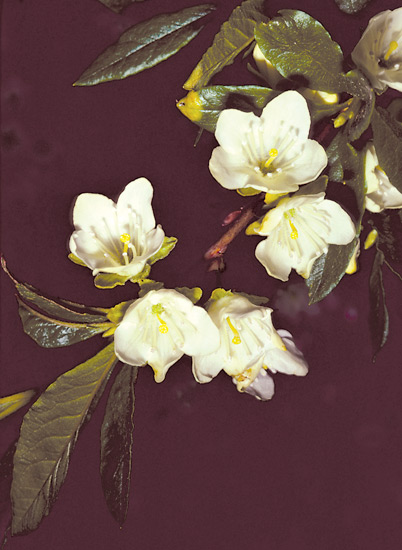
|
|
Rhododendron
albiflorum
Photo by Wilbur L. Bluhm |
R. macrophyllum , Pacific, or Western, Rhododendron is a coarsely branched evergreen shrub to 25 feet tall, typically 6 to 12 feet. It is tall and leggy in heavy shade, shorter and more compact in sun. Western Rhododendron is one of first shrubs to invade and colonize after a clear cut timber harvest. After a few years it can form nearly impenetrable thickets, the bane of forest workers.
Pacific Rhododendron grows from near sea level to near subalpine in the mountains, in conifer woods. Its range is from central coastal California northward along coast and in Cascade Mountains to extreme southern British Columbia Cascades and Vancouver Island.
Its leathery elliptic or elliptic-oblong leaves are about 3 to 8 inches long and a third, more or less, as wide. They are dark green above and paler underneath, without marginal teeth, glabrous or nearly so, on ½ to ¾ inch long stout petioles. The mid-vein is sunken.
The flowers are from deep rose to rarely white, few to many flowers in terminal umbel-like large trusses. Each flower is on an-up-to 2 inch long pedicel. The corolla is deeply 5-lobed, the crisply undulating lobes forming a broadly campanulate flower, 1 to 1½ inches long and to 2 inches wide. Inside, the corolla may be speckled green or red-brown.
Pacific Rhododendron is an attractive plant for the garden, perhaps not matching some of the more beautiful Asiatic species, but useful for the native garden or naturalized woodland. It is the state flower of Washington.
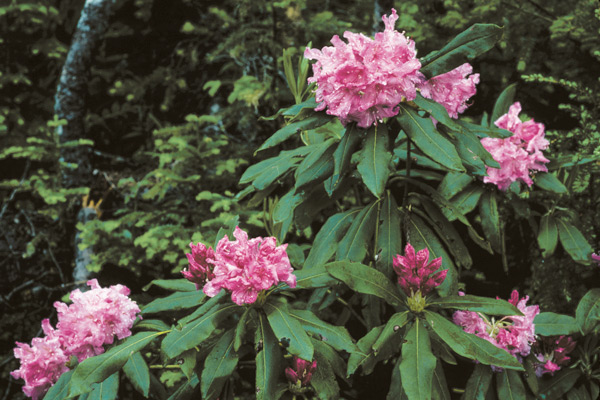
|
|
Rhododendron
macrophyllum
Photo by Wilbur L. Bluhm |
R. occidentale , Western Azalea is among the most beautiful American rhododendrons. It has been extensively used in azalea breeding programs to impart its outstanding fragrance, colorful flowers, and brilliant fall foliage to its hybrid offspring.
Its range is from southwest Oregon, from coast inland to about 50 miles, through mountains and valleys, up to 5,000 feet elevation, to San Jacinto Mountains of southern California, east and north of San Diego. It's common in moist thickets and seeps, and along streams, often in coniferous forests, on either serpentine or non-serpentine soils.
Western Azalea is a highly variable, slender-branched, upright, deciduous medium to large shrub, to 10 to 15 feet tall, but often shorter. Leaves are thin, 1 to 3½ inches long and ⅓ to 1¼ inches wide, and narrowly oval to lance shaped, usually wider at tip than at base. They are light green on upper surface and paler beneath. The leaf margin is hairy. Fall color ranges from yellow to a brilliant red.
Flowers are fragrant, in tightly compact clusters of 5 to 50, somewhat irregular, funnel-shaped, 1½ to 1¾ inches long and commonly 1 to rarely 4 inches across. They are found in various combinations of white, yellow, orange, and pink to red. The corolla inside is usually white, sometimes pinkish, with strong yellow to orange blotches. Petal margins may be entire, frilled, or notched, rarely petaloid. Flowers can be so numerous as to nearly enclothe a shrub.
Western Azalea is a prized ornamental shrub, adapting well to the moist gardens. Many selections have been made by collectors, based usually upon floral, occasionally foliage, characteristics, and are available in the trade. Many commonly-grown hybrid azaleas include Western Azalea parentage.
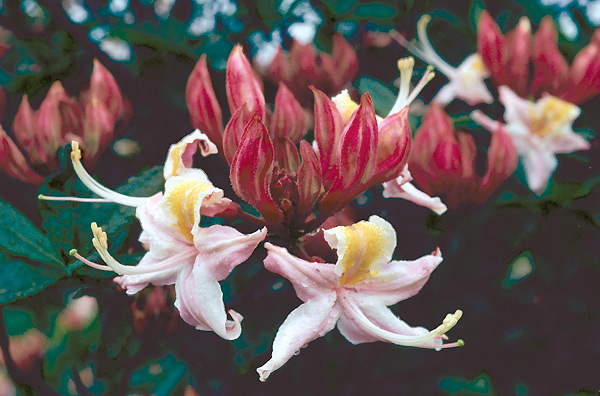
|
|
Rhododendron
occidentale
Photo by Wilbur L. Bluhm |
All Species of Vaccinium in the Northwest are trailing to erect, small to medium sized, shrublets or shrubs. Leaves are simple and alternate. All are deciduous with rather small thin leaves except for the leathery and small leaved evergreen V. ovatum and the much smaller V. oxycoccus . Twig characteristics are an identification feature. Fall color is from yellow to often brilliant red, especially in the higher mountains.
The 5 flower petals are fused to form a globose, ovoid, or urn-shaped corolla, the petals distinct only at outer edge of corolla. Stamens are twice the number of corolla lobes and are enclosed within the corolla. V. oxycoccus differs in having 4 petals that are divided to the base. Fruit is a red, blue, or blue-black many-seeded berry, with or without a bloom. Only three species - V. occidentale , V. ovatum , and V. uliginosum - produce berries in clusters, though V. oxycoccus may have several together. Cluster-fruited plants produce 10 to 20 times more fruit than single fruited ones of similar size and vigor.
Most species are good ornamental shrubs and sources of edible fruit. Many Northwest native Americans had favorite huckleberry patches that provided considerable food. Northwest vacciniums are closely related to the cultivated blueberries, which are also Vaccinium species.
Vaccinium cespitosum , Dwarf Huckleberry, Dwarf Bilberry is one of the smaller Northwest vacciniums, from 6 to 12 inches tall, occasionally to 20 inches. It spreads widely by rootstocks and forms mats. It is common along mountain hiking trails.
Dwarf Huckleberry grows in wet meadows, moist mountain habitats, and rocky ridges throughout the Northwest at elevations from about 100 to 10,000 feet. Its range is equally broad, from Alaska southward to central California, from the coast eastward to Idaho, Montana, and Rocky Mountains, and, further north, to Atlantic Coast.
Dwarf Huckleberry twigs are not to somewhat angled, yellowish-green to reddish colored. Leaves are ½ to 1¼ inches long, longer than broad, widest near tip, and with small teeth along upper margins, each tooth with a bristle-like hair. Flowers are single in leaf axils, nodding, about ¼ inch long, twice as long as broad, white to pink. The sweet and edible berries are globose, light blue to blue-black with a pale bloom, ¼ to ⅓ inch broad.
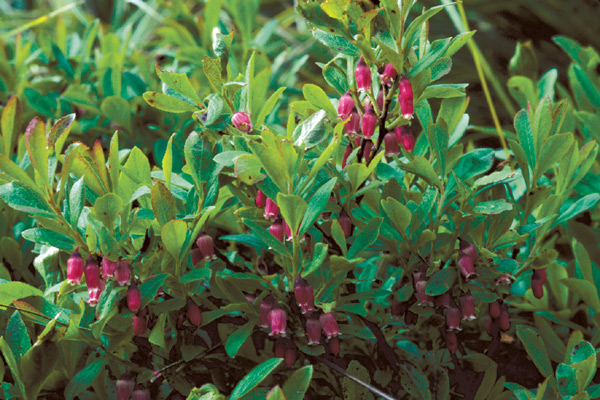
|
|
Vaccinium
cespitosum
Photo by Wilbur L. Bluhm |
V. deliciosum , Cascade, or Blue Leaved, Huckleberry is a low, densely branched and often matted shrub, near same size as the Dwarf Huckleberry. Cascade Huckleberry twigs are greenish-brown, inconspicuously angled, and smooth. Leaves also are similar to Dwarf Huckleberry in size and shape, except Cascade Huckleberry leaves have no hairs on teeth, have a waxy bloom on lower surface, are sometimes glaucous on upper surface, and may be 2 inches long, but usually much shorter.
Cascade Huckleberry flowers are single in leaf axils, nodding, nearly spherical, pinkish, and about ¼ inch long. Berries are blue-black with a bloom, ¼ to ⅓ inch broad, spherical, and "sweet and delicious." Its species name, deliciosum , alludes to the berries.
It grows in mountains, often subalpine to near alpine, from coastal British Columbia southward in Olympic and Cascade Mountains of Washington, and in Cascades as far south as central Oregon. Leaves turn a brilliant red in early fall at these elevations.
V. membranaceum , Big, or Thin Leaved, Huckleberry has some of best, and largest, fruits of Pacific Northwest vacciniums. The berries are ⅓ to ½ inch broad and dark reddish purple, purple, to purplish black and without a bloom. They are "edible and…deliciously flavored."
The flowers are single in leaf axils, about ¼ inch long and three fourths as broad, and creamy pink in color. Leaves are 1 to 2½ inches long, scarcely half as wide, and of variable ovate or oblong-ovate to elliptic-obovate - and long pointed. Leaves have small teeth for nearly full length, are strongly glaucous, and are glandular and paler underneath. They show various reddish colors and hues in fall.
The shrubs are 1½ to 6½ feet tall, and spread by rootstocks. Twigs are yellow-green and slightly angled. Bark on older branches is gray and peeling.
Big Huckleberry ranges from Alaska and British Columbia to northern California on both sides of Cascade and Olympic Mountains, to Wallowa and Blue Mountains of eastern Oregon and Washington, to Idaho, Montana, and, possibly, South Dakota. Its habitat requirements are less critical than for many other western vacciniums. It grows on mountain slopes, wet meadows, and in dry coniferous forest sites at about 500, in north, to 7200 feet in California.
Red-berried forms have appeared sporadically in Stevens Pass, Washington, in Siskiyou Mountains of California, and possibly elsewhere. The Globe Huckleberry, V. globulare , formerly treated as a separate species, is now classified as V. membranaceum .
V. myrtillus , Dwarf Whortleberry; Dwarf, or Low, Bilberry has a wide range but is not always common within its Northwest range. It grows in the mountains, up into subalpine zone, in Rocky Mountains of southeast British Columbia, in Wenatchee Mountains of eastern Washington, in Idaho, and from a few sites in Cascade, Siskiyou, Strawberry, and Blue Mountains of Oregon. In Oregon its elevation range is 3800 to above 9000 feet.
It is also reported from southwest Alberta, Montana, Wyoming, Utah, to New Mexico and Arizona, Northern Europe, and Eurasia. Its preferred habitats are for moist conditions in dry bogs, shady woods, and wooded rocky outcrops.
Dwarf Whortleberry is 6 to 18 inches tall, erect, and freely branched. Twigs are green to greenish brown, strongly angled, crooked, and with very short hairs.
Its leaves are light green above and paler below, ½ to an inch or more long, ¼ to ⅔ inch wide; ovate to more or less broadly elliptic in shape; with prominent veins on undersurface, and small sharp teeth on margins.
Flowers are single in leaf axils, nearly ¼ inch long, from somewhat narrower to usually as broad as long, and pinkish. Berries are globose, less than ¼ to ⅓ inch in diameter, dark red to blue-black without bloom, edible and "sweetish".
Both leaves and berries are dried and used as herbal remedies, especially in Europe, where it is sometimes cultivated as an alternative crop to blueberries.
V. occidentale , Western Huckleberry, Western Bog Blueberry inhabits bogs and very moist to wet meadows from, rarely, near sea level to, commonly, in the mountains upward to some 10,000 feet in southern extension of its range. It's found from southern British Columbia southward to northern California and east to Montana and Nevada. Its principal range in Northwest is in the Cascade Mountains, and probably not east of the Cascades.
Western Huckleberry is an erect, or prostrate, many-branched shrub, 10 inches to more than 2 feet tall, with or without rhizomes. It can be in large patches of several acres or more. Twigs are round, yellow-green, smooth, and rigid.
Leaves are without teeth, thin, ½ to 1 inch long, usually less than half as broad, wider above the middle than below, green and pale on both surfaces, visibly but not prominently veined on lower surface.
There are 1 to 4 flowers per leaf axil. Each is about ¼ inch long and quite narrower, and dark pink to white. Berries are blue to black with bloom, spherical, about ¼ inch in diameter, in clusters, sweet but not of best quality.
Some references list Western Huckleberry as V. uliginosum ssp. occidentale .
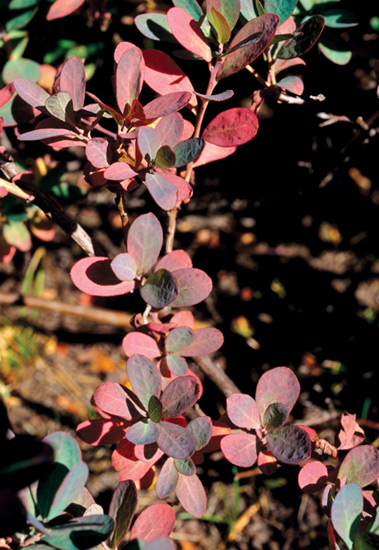
|
|
Vaccinium
occidentale
Photo by Wilbur L. Bluhm |
V. ovalifolium (alaskaense), Early Blueberry, Oval Leaved Huckleberry is the earliest flowering of Northwest vacciniums, flowers emerging before or with the leaves. It is also one of largest, growing 2 to 10 feet tall.
Early Blueberry is a slender, spreading shrub in coniferous forests along the Pacific Coast and drier woods in the interior, from Alaska to south central Oregon, east to Montana, and in eastern United States and east Asia. In the Northwest it is most common in the Cascade Mountains and westward. Its elevation range is from sea level to 6500 or more feet.
Twigs are yellow-green, conspicuously angled, and smooth. Old branches are gray. Leaves are oval or oblong, ¾ to 2 inches long, smooth or with very slightly toothed margins, and without hairs. They are green on upper surface, pale green or glaucous with waxy bloom on lower surface.
Flowers are single in leaf axils, about ¼ inch long and almost as broad, and pinkish. Berries are bluish- or purplish-black with bloom, spherical, about ⅓ to ½ inch in diameter, and "edible and of good flavor" but drier than fruits of some huckleberries.
V. ovatum , Evergreen Huckleberry, Evergreen Blueberry is west of Cascade Mountains, from southern British Columbia south to redwoods area of California, sporadically south to Channel Islands of southern California. It is primarily a coastal species but there are scattered sites in Oregon Cascades, and possibly in Washington, and many sites in Siskiyou Mountains of southern Oregon and California. Elevation range is from near sea level to 4400 feet or more in its less common mountain sites.
Evergreen Huckleberry shrubs grow 1½ to 10 feet tall. Twigs are covered with very short hairs. The attractive, ¾ to 2 inches long, evergreen leaves are very numerous, leathery, glossy dark green above, and paler beneath. They are narrowly egg-shaped, have pointed tips, and the thickened margins are sharply toothed.
Flowers are in small clusters of 3 to 10 in leaf axils, from white to bright pink. They are about ¼ inch long, narrower than long. The small, shiny, purplish black to black berries are spherical, and ¼ inch or less in diameter. Though small and acid, berries are edible.
This is most commercial of all Pacific Northwest vacciniums. It's an excellent ornamental and widely used in landscape trade. The foliage is commonly used in the florists trade. While there is great variation in color and quality, the fruit is gathered extensively for table use. Selections chosen for fruit quality and production are now available in the nursery trade.
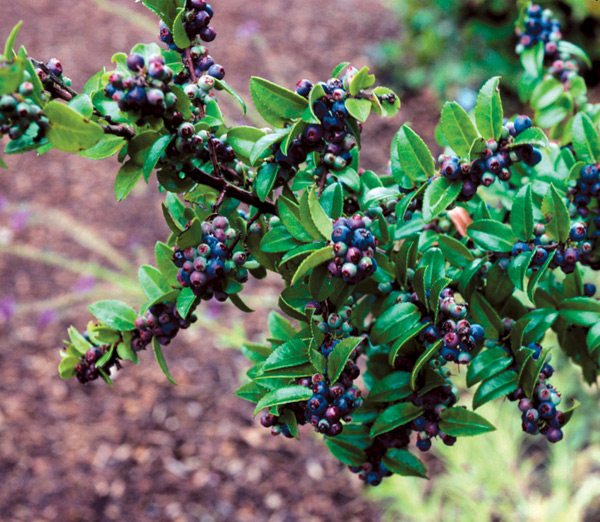
|
|
Vaccinium
ovatum
Photo by Wilbur L. Bluhm |
V. oxycoccos , Wild, or Swamp, Cranberry is similar to the cultivated cranberry, V. macrocarpon , which has become wild in Pacific Northwest. Wild Cranberry occurs across Canada, south to central coast and Cascade Mountains of Oregon and in Idaho in Northwest, and to north central and northeast U.S., and Eurasia.
Wild Cranberry is usually a sphagnum bog plant, the bog sometimes shaded or partially shaded by trees. In the Northwest it occurs from near sea level to 4000 feet or more in the mountains. This is a diminutive plant in most aspects. It is a creeping shrub with very slender stems. The persistent evergreen leaves are less than ¼ to nearly ⅔ inch long, egg- to lance-shaped, shiny deep green on upper surface and grayish beneath, with margins strongly rolled under (revolute).
Flowers differ from other Northwest vacciniums. The 4 petals, less than ¼ to ⅓ inch long, are divided to the base. They are also reflexed, or re-curved, back toward base, exposing the style and filaments. There may be one to several pink flowers either at end or laterally on stem, each on a very slender ¾ to 1½ inch long stem, the longest among Northwest vacciniums.
The dark red, rather sour, berries are about ¼ inch in diameter.
V. parvifolium , Red Huckleberry, Bilberry, or Blueberry is another large vaccinium, 2 to 12 feet or more tall. It is an erect shrub with slender stems that grows in mostly moist and rather shady habitats, especially on logs and stumps where bird-planted. It occurs in lowlands and into mountains from southeast Alaska and southern British Columbia to central California, in Cascade, Klamath, and Siskiyou Mountains and west to Pacific coast. Elevation ranges from near sea level to 5000 feet.
Red Huckleberry twigs are green and very strongly angled, almost square. The green and thin, deciduous, 1 inch or longer, toothless or toothed leaves are oval to elliptical in shape and have prominent veins on underside. They may take on reddish colors in fall before reluctantly dropping.
Flower color can be white to greenish–white or greenish–yellow, to pink, and are waxy. Flowers are single in leaf axils, each less than ¼ inch long, and as wide or wider than long.
The berries, bright red when ripe, are ¼ to almost ½ inch, and spherical. Although sour, they are of good flavor.
Red Huckleberry is an attractive and versatile ornamental. It enjoys, and does well, in a rhododendron bed or garden, where it will likely self-sow and increase.
V. scoparium , Grouseberry, Whortleberry, Littleleaf Huckleberry resembles a miniature Red Huckleberry. Both are upright growers with strongly angled green twigs, similar colored flowers, and red berries. Heavily branched Grouseberry plants remind one of a whiskbroom.
Grouseberry may be but a couple inches to a little more than a foot tall. In its mountain habitats it can form mats of several hundred square feet to an acre or more, usually at edge of or in open coniferous woods.
Its range is from southern British Columbia to northern California's Klamath Mountains, eastward to Alberta, South Dakota, Colorado, Utah, and New Mexico. Grouseberry is a subalpine to alpine plant, growing at elevations to 8000 feet and more, but will grow below subalpine to 2000 feet or lower, especially in its northern range.
The light green Grouseberry leaves are narrowly oval or lance-shaped, ¼ to ½ inch long and less than ¼ to ⅓ inch wide, with small teeth along the margins, and are strongly veined on under surface. They turn red in fall before dropping.
Flowers are single in leaf axils on nodding short stalks (pedicels). Each is to 1/6 inch long and broad, often barrel-shaped. Bright red or orange-red berries, from much less than to ¼ inch diameter, are tart to sweet and palatable, but usually left to birds and other animals.
V. uliginosum , Bog Blueberry, Bog Bilberry is a stiff, erect or prostrate, freely branching shrub, 6 to 20 inches tall, though it may reach 30 inches. Older branches are grayish-red, and twigs are yellow-green and round, not angled. It grows in swamps, bogs, wet muskegs, wet meadows, and moist coniferous woods.
In Pacific Northwest it occurs from Alaska and British Columbia, through Washington, Oregon, to northern California and east to Idaho. Here it grows from near sea level to 6000 feet and possibly higher. In its broader range, which is circumboreal to Montana, Nevada, Utah, Wyoming, and across extreme northern U.S. to New York, it is found to 11,000 feet and higher.
The deciduous Bog Blueberry leaves are ⅓ to an inch long, longer than wide, wider above the middle than at base. They are f1rm and thick at maturity, without margin teeth, green above and pale or glaucous below, with visible bur not prominent veins on underside.
In flowering Bog Blueberry is a bit of an anomaly. Its flowers are single, or in a cluster of 2 to 4, in leaf axils. The calyx and corolla are 4 or 5 lobed. Each pink flower is nearly ¼ inch long but only two thirds or three fourths as wide. The dark blue to black, with a bloom, berries are spherical, about ¼ inch in diameter, "edible and sweet."
Wilbur Bluhm is a member of the ARS Willamette Chapter and of the Willamette Valley Chapter, Native Plant Society of Oregon. He is retired from Oregon State University Extension Service where he was an Extension Horticulturist, staff chairman of the office at 5alem and now Professor Emeritus.
